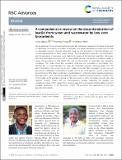| dc.description.abstract | The disadvantages of conventional methods in water and wastewater management including the demand
for high energy consumption, the creation of secondary toxic sludge, and operation cost are much too high
for developing countries. However, adsorption using low-cost biosorbents is the most efficient nonconventional technique for heavy metals removal. The high adsorption capacities, cost-effectiveness,
and the abundance of agricultural waste materials in nature are the important parameters that explain
why these biosorbents are economical for heavy metals removal. The present investigation sought to
review the biosorption of lead [Pb(II)] onto low-cost biosorbents to understand their adsorption
mechanism. The review shows that biosorption using low-cost biosorbents is eco-friendly, costeffective, and is a simple technique for water and wastewater treatment containing lead(II) ions. The
batch biosorption tests carried out in most studies show that Pb(II) biosorption by the low-cost
biosorbents is dependent on biosorption variables such as pH of the aqueous solution, contact time,
biosorbent dose, Pb(II) initial concentration, and temperature. Furthermore, batch equilibrium data have
been explored in many studies by evaluating the kinetics, isothermal and thermodynamic variables. Most
of the studies on the adsorptive removal of Pb(II) were found to follow the pseudo-second kinetic and
Langmuir isotherm models with the thermodynamics variables suggesting the feasibility and
spontaneous nature of Pb(II) sequestration. However, gaps exist to increase biosorption ability, economic
feasibility, optimization of the biosorption system, and desorption and regeneration of the used
agricultural biosorbents. | en_US |

